Leo Tamaki Sensei began his aikido training under Nobuyoshi Tamura and moved to Japan in 1998 to train at the Aikikai Hombu Dojo. He returned to France in 2001, where he opened up a martial arts equipment business and began a martial arts blog. Tamaki returned to Japan in 2007, training there for three more years. He returned in 2010 and took to teaching aikido full-time. He currently heads Kishinkai International and has appeared earlier this year with Jesse Enkamp on YouTube.
Josh Gold: Let’s start with some background on your study of the martial arts.
Leo Tamaki: My father is Japanese, and when I was five, I wanted to do ballet – classical dance. But my mother thought it would be better for me to do something from the culture of my father, so I ended up starting judo at five. And then when I was eleven, Jackie Chan and Bruce Lee’s movies started to air on TV. So, I asked my parents to do kung fu. Later, I got into karate and kickboxing, and finally aikido.
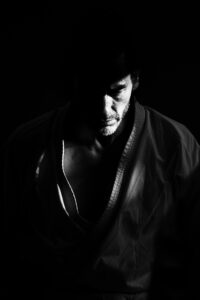
What was your motivation to transition from karate to aikido?
At one point, I considered becoming a professional karate teacher. The kind of karate I did was very athletic and I was quite physical. I assumed it would not be suitable for older people and children. But I knew that a dojo should have activities for everyone, so I thought I’d do some tai chi, yoga, or aikido. And I settled on aikido, thinking I would learn some wrist locks.
So where did your exploration of aikido go after that?
I ended up in a dojo where after the second class the teacher asked me, “Are you doing something this weekend? There is a seminar with this Japanese master.” It was a few hundred kilometers from Paris but I joined.
When I got there and saw the teacher, I said to myself that this was going to be a long and boring weekend. I was an athletic twenty-one year old and the teacher was a skinny old guy. He was no match in my world. But then at one point he called me up and wiped the floor with me. I cannot even say he kicked my ass because it would mean that he had to put in some effort. It was so effortless, it was shameful. The master was Nobuyoshi Tamura.
It was such a shock. I had read that athletics were just the first step in martial arts practice -that you had to transcend this level, but I thought it was fantasy. I was really shocked… and convinced of the greatness of aikido.
And that inspired you to focus your martial arts training on aikido?
In less than three months I stopped karate and went full-time into aikido. My teacher in Paris was a professional instructor, and he offered twenty-nine hours of classes. I went to all of them, even the children’s classes. Two years later I went to Japan to train at the Aikikai.
Why did you go to Japan so early in your path?
It was a very materialistic reason. I was happy with Tamura Sensei’s teaching. So the trip was not to go and look for something special. But at the time I already thought about becoming a professional aikido teacher. And in France, the federation rule is there’s a minimum requirement of three years for first dan, two more for second dan, and then three years for third dan. It didn’t matter that I was practicing thirty hours a week. In Japan things would go faster as long as you had your number of practice days.
Did you have any expectations of what training in Japan would be like?
Oh I had high hopes on this level. It just wasn’t my primary reason to go. I had bought some videos from Aiki News (later becoming Aikido Journal), I had the Friendship Demonstrations, some videos from Gozo Shioda Sensei, and some of O-Sensei. However when I arrived in Japan, I was very disappointed.
I remember the first class very well. It was the day after my arrival at three in the afternoon, with maybe twenty people attending. Some young students and some old guys. I was expecting a den of ninjas – super samurai and the whole thing. But the training level was very low. I immediately wanted to go back to France but I had no money (laughs).
So, what did you do?
I had to go and work construction. And after a week, I cooled down. It was not what I expected. I thought the teachers were not as good as Tamura Sensei and the level of practice was very low. This probably was not actually the case, but more so that they didn’t do things in the same way. Anyway, after a while I started to appreciate the fact that there are some different ways of doing things and I decided to make the most of it.
At the time at Hombu, only one teacher on the second floor was not a direct student of O-Sensei. So I had the privilege to practice with a lot of O-Sensei’s uchi deshi. It opened my mind, and I couldn’t think anymore that there was one way to do a technique.
Any other key differences you noticed between your practice in France and in Japan?
I came to understand that in Japan, people practice for pleasure. There is absolutely no violence in the country. So they don’t know what martial efficiency is, and most are not even looking for it.
What was your next step?
I came back to France in 2001. There was one opportunity because one of my senpai was leaving a dojo. I thought I was coming back from Japan to make a living out of aikido, but I found out that it was in a far suburb of Paris, and that there were only four adults and nine kids (laughs).
“I said to myself that this was going to be a long and boring weekend. I was an athletic twenty-one year old and the teacher was a skinny old guy. He was no match in my world. But then at one point he called me up and wiped the floor with me. I cannot even say he kicked my ass because it would mean that he had to put in some effort. It was so effortless, it was shameful. The master was Nobuyoshi Tamura.”
My wife was Japanese and didn’t speak French, so I had to take three jobs, and teach the classes. But at the end of the first year I had 50 students. And after five years I had more than a hundred. I also started to teach in other dojo and everything went well quite quickly.
So why did you go back to Japan again?
In parallel to the classes, I founded a martial arts company selling Japan made products, with a website and a retail shop. I had also opened a Japanese art gallery. Meanwhile my wife went back to Japan to study traditional medicine.
At first, I used to visit her every three months. But the busier I became, the less I went. Until in 2007 my wife finally asked for divorce. As soon as I received the message, I closed my laptop, went to the airport, and took the first flight to Tokyo. It took me six months to understand it was too late. But I was in a good stride in terms of practice, training with Kuroda Sensei, visiting Akira Hino, Yoshinori Kono and others. So I stayed until 2010.
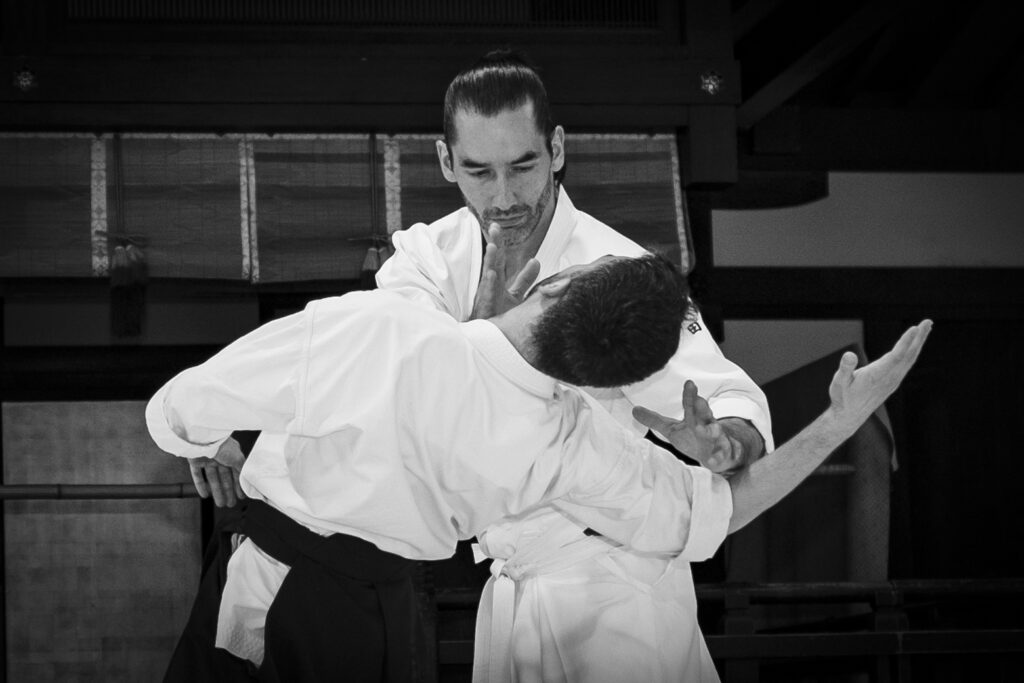
What were your ambitions when you started teaching?
The first year I started, my daily teacher received his fifth dan. So I thought “Okay, maybe I will also reach fifth dan one day, have 50 students, and make a living out of aikido.” It may look like low expectations, but in the 90s we didn’t have the grading inflation yet. Fifth dan were still rare. Maybe forty or fifty for about 70,000 practitioners. One in a thousand would reach fifth dan. So I was happy to settle being a blue-collar aikido professional.
What do you mean by blue-collar aikido professional?
In aikido you can make a living as a blue collar or a white-collar. Blue-collar is what I did at first. I took a dojo, built it up, and another one, then another one. Until at the end I was teaching four or five dojo at the same time. I was teaching 20 to 30 hours of classes every week.
You give morning class, you take a shower, go to another place to teach a noon class, then to another place in the evening, and so on. This is a blue-collar job. You can make a decent living, but you go from one class to another and are a slave of the students. On the opposite side, you have the white-collar, the expert living from the seminars. It asks for a higher level of expertise, but also leaves you more time to practice and improve.
How did you make the transition?
I could have stayed in the blue-collar zone because everything was going very well. But the problem with my wife brought me back to Tokyo. I had started a blog in 2004. I was not very active initially, but in 2007 when I went back to Japan, I started to write a lot. I thought I would come back quickly, and I wanted to keep in touch with my students. But readers started to come from lots of different dojo. In the end, I had 2,000 unique visitors every day. For a martial blog in French, it was a big deal. People started to invite me to give seminars in 2008 while I was still in Japan, and it accelerated when I came back in 2010. In less than five years I had more invitations than there were weeks in a year, and had to refuse seminars.
What did it change for you?
I keep teaching classes on the weekdays, but only twice. So I had time to practice for myself. And this is exactly what Tamura Sensei did. He gave two classes a week. The rest of the time he was focusing on his own practice and giving seminars all over the world. That’s also what Tissier Sensei did.
It’s very different because when you’re a blue collar, you live off your passion. But at the same time, you don’t have the will to train outside the classes because you already have spent thirty hours on the mat. You don’t have energy to do outside research and focus on your own training. You can get stuck in a cycle where you become good at teaching, but your own level of practice doesn’t increase.
“I remember the first class very well. It was the day after my arrival at three in the afternoon, with maybe twenty people attending. Some young students and some old guys. I was expecting a den of ninjas – super samurai and the whole thing. But the training level was very low. I immediately wanted to go back to France but I had no money.”
On the other hand, when you teach in seminars, your level has to go up. You have to make an impression on the people who came to visit you the first time you meet. But you have time to improve for this. I practice almost every day now. I didn’t do this when I was in the blue-collar mode, because I didn’t have time and energy. I would go to one or two seminars a month to train with Tamura Sensei. That was usually the total of my own training.
What do you do for your training and development?
First of all, I go to Japan once or twice a year. I bring students and we visit 10 or 12 different teachers. In the past we went to meet people like Kanshu Sunadomari, Seiseki Abe, etc. who have now passed away. Now we go to practice with Morito Suganuma in aikido, Hatsuo Royama and Hironori Otsuka in karate, Takeshi Kawabe in Daito ryu, and so on. This is one way I improve.
The second thing are seminars where classes are given by other teachers of our school, Kishinkai. It allows me to simply practice. Say nothing; correct nobody; just practice. Then there is my own private practice where I train with my students, my brother, or solo weapons practice. Finally there is athletic and physical conditioning that I also do every day.
One teacher that I interviewed, Jean-Marc Chamot, said it very well. He was a close student of Tamura Sensei and Sugano Sensei. He said that, while you are tori, you learn to use your body in a different way. A new body mechanic. But physical conditioning is what keeps you flexible. Do you know Suganuma Sensei?
I’ve never met him personally.
He’s in Kyushu. He’s 82 now, I think. So, I was at his dojo recently. He is so flexible that he does a full split during the warm up. During class, he shows a technique, then he moves around, grabs you and takes ukemi before applying it in turn.
During the first class of the year he called on one of the students “Nakahashi-san, please do a demonstration.” The guy stands up and calls a young student. He grabs him and starts taking ukemi. Then he throws the guy. At the end Suganuma Sensei said, “This is Nakahashi-san. He’s 92.” I was like, what? The guy looked like he was in his late sixties and was in tip top shape! I think that being uke and taking ukemi is what keeps you in good shape. Teachers who didn’t take ukemi were not in such good physical shape.
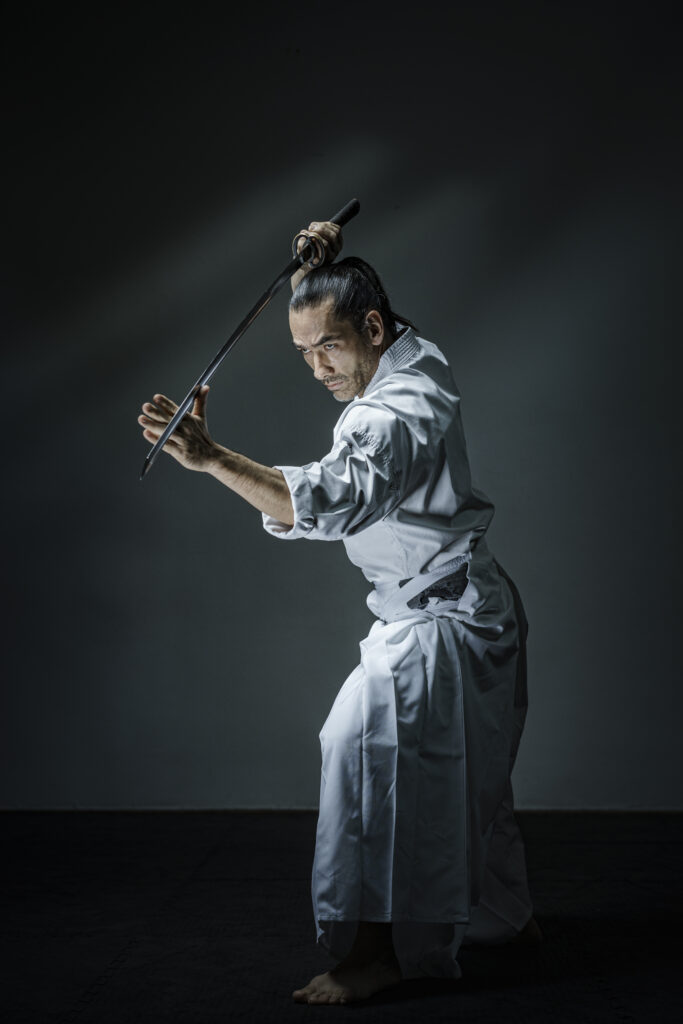
You mentioned Abe Sensei. How much did you train with him? My teacher brought him out to California a number of times and I lived in his dojo for two weeks in the early nineties.
I met Abe Seiseki Sensei once, and a few times his son, Abe Houn. I met Abe Sensei once, and did a quick interview a few months before he died. He was incredible.
I don’t think they received, at the time, too many outside students or people from other countries. So they received us very kindly. They brought out all the O-Sensei calligraphy, and Abe Sensei who didn’t come for quite a long time showed up. He came and looked at the class seated. Then his son came and asked, “What should I do?” Until now, the son would ask, and the father would say, “You make them practice this and that and that.” But this day, for the very first time, Abe Sensei said, “This is your dojo. You can teach whatever you want.” And he died a few months later. So, I never practiced with him. I practiced with his son, maybe 10 times – not much.
“…you don’t have the will to train outside the classes because you already have spent thirty hours on the mat. You don’t have energy to do outside research and focus on your own training. You can get stuck in a cycle where you become good at teaching, but your own level of practice doesn’t increase.”
Tell me a little bit about some of the other marital arts teachers you’ve trained with – folks like Kuroda Sensei, Akuzawa Sensei, and Kono Sensei. I’ve met all of them, but have not trained with them enough to really get a deep understanding of what they’re doing.
Well, the one with whom I trained the most was Kuroda Sensei, for 14 years. I invited him to Europe twice a year for one-week seminars, 36 hours of classes. I was taking maybe 90% of his ukemi there and a lot in Japan as well. Kuroda Sensei’s quality of movement was unparalleled, but I found too many discrepancies between his claims, the acts and the historical facts. And there were things that I didn’t want to accept. So I cut ties with him, and told him exactly why. But the quality of movement and the insights were very inspiring, and I am where I am thanks to him.
What about Akira Hino Sensei?
Hino Sensei is the second one with whom I practiced the most. Of all the teachers that I followed, he’s the one who devised the best system. His method is simple – not easy – but clear and efficient. I don’t use Hino Sensei’s wave movements, one of his trademarks that allows him to have surprising power. But I’ve been inspired by his incredible sensitivity. And his quality of contact. The way he can take information from you without giving any is really unbelievable.
I also worked on the principle of extending a move before returning it. I use it in a different way from his, but it was a precious teaching. People usually attack you in a flow. And if you disturb their first movement, they immediately go on with the next. So I think it’s very important to accept the attack instead of blocking or deviating it.
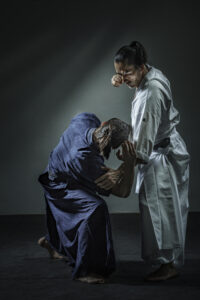
And Akuzawa sensei?
Akuzawa sensei is good at is receiving power and generating it. He uses the word bujutsu, but I think that what he does is mostly tanren/misogi. What he does he does very well, and I bring students to see him every year because he’s impressive. But I’m not interested in it personally because as soon as there is a weapon, it is not as important. You may be a powerful 200 pound guy. If you face a 100 pounds girl, she has a big problem. Now if she has a knife – it’s an equalizer. The fact that you’re twice her weight almost doesn’t count.
And finally, Yoshinori Kono Sensei?
Kono Sensei is very different. He’s the most passionate of all the teachers that I met. More than any of them. He’s also very open. He goes to other people’s seminars of any art as a student. Some teachers, they just stop and keep their level of ability. Some progress but slowly. But Kono Sensei kept progressing more than anyone.
The “difficulty” with him is that he thinks of a problem and brings a solution. But in one situation, he would use some body mechanic. In another situation, another body mechanic. One strategy, another strategy, and so on. So there is no definite method, but just the result of a lifetime of constant practice. Impossible for most to grasp.
This is part 1 of a 2 part interview. Part 2 will be published next Thursday.
More information can be found on Nobuyoshi Tamura Sensei in Aikido Pioneers: Postwar Era, along with accounts from Morihiro Saito, Seiseki Abe, Katsuaki Asai, T.K. Chiba, Seishiro Endo, Masatake Fujita, Shizuo Imaizumi, Kayoichi Inoue, Hiroshi Isoyama, Mitsunari Kanai, Yasuo Kobayashi, Shoji Nishio, Mitsugi Saotome, Masando Sasaki, Kenji Shimizu, Seichi Sugano, Hiroshi Tada, Hideo Takahashi, Mariye Takahashi, Nobuyoshi Tamura, Moriteru Ueshiba, and Yoshimitsu Yamada.

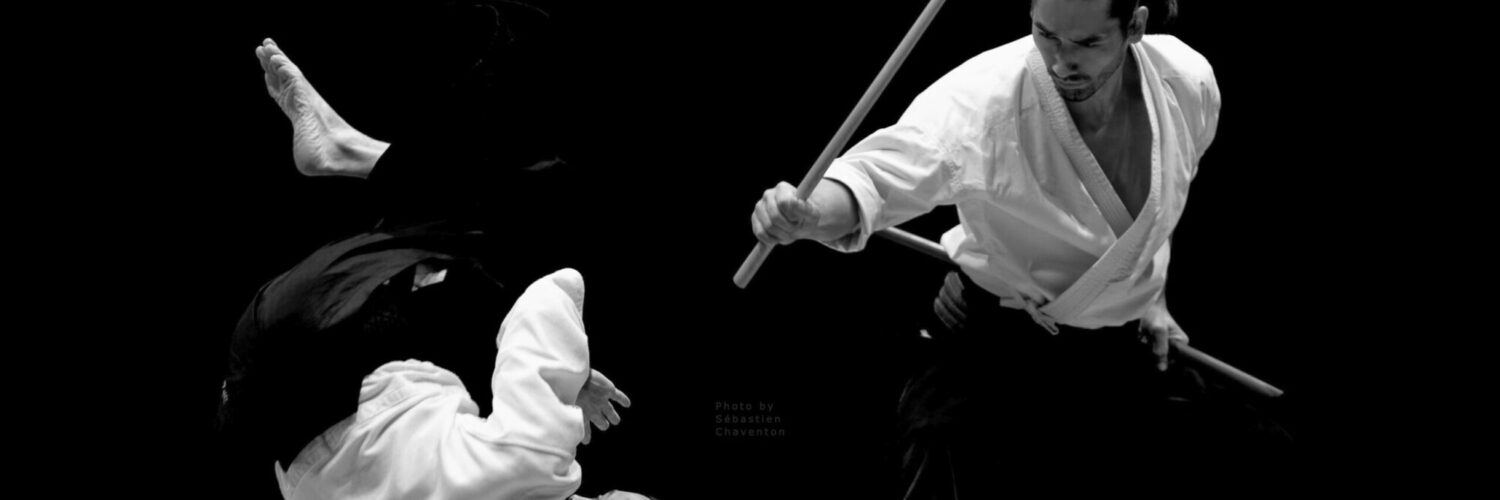


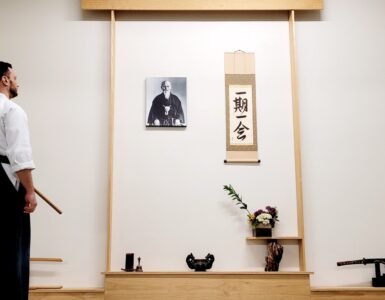








Dans la liste du livre, Aikido Pioneers Postwar Era, vous oublié Morihiro Saito.
thank you, lots of insights
Excellent interview and insights.
Wonderful interview, quite insightful. Looking forward for Part II.
Cheers!
Beto
I was at Suganuma Sensei’s class that is mentioned in the interview. FYI, the 92-year old practitioner is Takahashi-san. I posted a video of him doing breakfalls and jumping full tatami-mat lengths back when he was 86. He’s still training.
I have to say that I was very inspired training, albeit briefly, with Tamaki and his students. Hopefully I’ll be able to do so again this coming year. His insightful thoughts are also most welcome.
I find it extremely interesting and perhaps unique that aikido can be practiced in so many different ways and yet still be recognizable as a distinct art. It speaks to the brilliance of O’Sensei that he devised an art form that can be “customized” to each individual practitioner and still retain the essence of a distinct form. Altogether a very insightful and thoughtful interview with one who has sought to distill the essential nature of aikido.